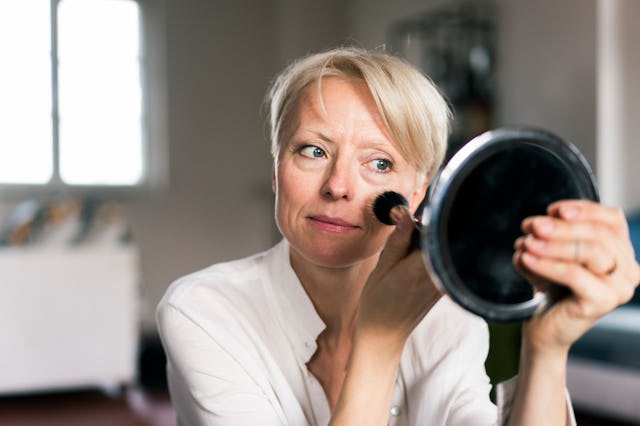How Are We Preventing Our Foundation & Concealer From Creasing? I Asked Four Professional Makeup Artists
Like, why do I look worse when I wear foundation now?

Whether you love to spend your time getting ready — putting on a full face of makeup and primping at your own pace — or you like to swipe on a few products and get on with it, there comes a time when what has always worked well on your skin just... doesn’t anymore. As we develop fine lines on our faces, sometimes adding makeup just makes us look older as it creases into and accentuates each little wrinkle (so rude). So, we asked professional makeup artists how to stop foundation and concealer from creasing, even if there’s a fine line or wrinkle hiding underneath.
As someone who has watched enough hours of beauty tutorials on YouTube that I should have a degree, I learned how to do my foundation and concealer in a specific (and often heavy-handed) way. But the perfectly smooth and unbending skin of my 20s is no more, and in my 30s, my old ways of doing my base makeup tend to just emphasize all the fine lines around my eyes and mouth. So, how should I be putting on these products now, or do I just need to replace them all with something different?
The Best Foundations If You Have Wrinkles & Fine Lines
Steer clear of heavy, mattifying foundations and concealers, makeup artists say.
“When looking at foundations and concealers for fine lines or creasing, I always recommend looking for both hydrating and lightweight formulas,” says celebrity makeup artist and Catrice brand partner Emily Gray Higgins. “Hydrating because formulas that dry out the skin will emphasize fine lines, dry them out further, and emphasize any texture. Lightweight because if the formula is heavy, it will sink into any fine lines, wrinkles, or texture.”
“Look for lightweight, hydrating products like creamy concealers or a tinted moisturizer with a luminous, serum-like finish. These move with your skin’s natural expressions instead of settling into fine lines,” says Sara Kuhl, makeup artist and product education director at SeneGence.
Both artists say tinted moisturizers and serum foundations are great options to avoid creasing. If you want more coverage, try to find concealers and foundations that contain hyaluronic acid or other hydrating ingredients to give your skin a helping hand. In fact, using smaller amounts of high coverage products is what Tayaba Jafri, makeup artist and global beauty director at Laura Mercier, recommends.
Just don’t go too heavy. “Flexibility is key, so steer clear of anything labeled ‘matte full coverage,’ unless it also boasts skin-loving ingredients. Instead, opt for radiant or satin-finish formulas,” Kuhl says. You may have to try a few new foundations to find your perfect match, but these tips will guide you there pretty quickly.
How To Apply Foundation & Concealer To Avoid Creasing
Dry under-eyes or dehydrated skin will pull foundation into fine lines even more, Kuhl says, so prepping your skin with a hydrating toner, serum, or moisturizer first goes a long way in helping your makeup apply smoothly. Higgins seconds this, pointing out that our under-eyes don’t produce natural oils like the rest of our skin, so they’re the most likely area to need a little hydration boost. After that, it’s all about how you apply.
“To avoid creasing, less is always more,” says Brenda Orduno, professional makeup artist and Beauty Creations Cosmetics senior product developer. I’d start by applying a thin, even layer of product and only build coverage where it’s needed. For concealer, avoid over-applying under the eyes, and instead, concentrate it on targeted areas like the inner corners, then blend outward. Letting your concealer sit for a few seconds before blending also helps it cling to the skin better.”
Jafri agrees: “Oftentimes people put concealer everywhere under the eye. Only apply where you need it and press to melt it into place — no rubbing. Avoid concealers in areas where you want to avoid fine lines. Powder softly for a blur.”
You can also let your foundation warm up a bit on the back of your hand before you apply it if it feels heavy or stiff, Kuhl says. “This softens the texture and helps it glide on more smoothly and evenly. Also, a small dab of primer mixed in can help the products have a slight vehicle to glide nicely onto the skin.”
The tools you use can make a difference, too. Orduno recommends using a damp makeup sponge to blend out your base products instead of a brush because “it presses the product into the skin rather than letting it sit on top, which helps create a smooth, second-skin finish and minimizes the chance of settling into lines.” Setting your makeup with a puff sponge also helps set product into deeper crevices, she says.
It’s powder that usually makes or breaks your makeup if you have fine lines. I asked Higgins why sometimes powder makes me look like the crypt keeper, and she said applying it correctly is key. Opt for a finely milled powder, she says, and instead of a fluffy brush like I’ve been using, dab a powder puff into the product. Tap off the excess — “You do not want too much powder, as that will only add to lines and bog down your under eyes,” she says — and press the puff gently into the areas where you put concealer.
A hydrating or radiant setting spray to finish your look will help the powder look less stiff and more skin-like, Orduno and Higgins agree.
So, while creasing is totally normal and bound to happen here and there, it’s nice to know some new tricks for making your makeup look its best.